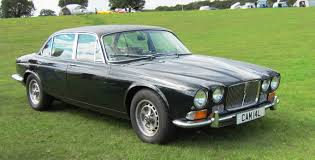-
Insurance
InsuranceAbout our productsLearn about insuringGet a quote Get current values, historical values, model history and more.
-
Valuation
ValuationHagerty valuation toolLook up a vehicle value Get current values, historical values, model history and more.
-
Events
EventsHagerty official eventsHagerty ClubhouseEvent calendar
-
Entertainment
EntertainmentMore to explore
- Portal login
1973 Jaguar XJ12
SI 4dr Saloon 5.3 L
Vehicle values by condition
Fair
Condition 4
£4,900
#4 cars are daily drivers, with flaws visible to the naked eye. The chrome might have pitting or scratches, the windshield might be chipped.
Good
Condition 3
£8,600
#3 cars could possess some, but not all of the issues of a #4 car, but they will be balanced by other factors such as a fresh paint job or a new, correct interior.
Excellent
Condition 2
£14,000
#2 cars could win a local or regional show. They can be former #1 cars that have been driven or have aged. Seasoned observers will have to look closely for flaws.
Concours
Condition 1
£26,300
#1 vehicles are the best in the world. The visual image is of the best car, unmodified, in the right colours, driving onto the lawn at the finest concours.
Insurance premium for a
1973 Jaguar XJ12 SI 4dr Saloon 5343
valued at £8,600
£123.45
/ year*
History of the 1972 - 1973 Jaguar XJ12

1972 - 1973 Jaguar XJ12
The Jaguar XJ-series is a large four-door saloon car and two-door coupe, built from 1968 to 1992. Styled by company founder Sir William Lyons, it is a front-engined, rear-wheel-drive car seating four to five people. It is considered to be one of the most iconic large saloon cars of its era.
The XJ was the first all-new Jaguar saloon since the Mark X luxury liner, and was set to rationalise the confusing saloon range into one single model. Everything from the 240 to the Mark X would eventually be replaced by the XJ. In 1972 Jaguar introduced both a long wheelbase option and the new 5.3-litre V12 engine, first seen in the E-type.
The Series 2 was launched in 1973, and with it, the XJC. The XJC was a two-door pillarless saloon, marketed as a coupe. It was available as a 4.2-litre six and a V12, and was produced until 1978. The XJC was discontinued as increased XJ-S sales effectively took its place.
For 1979 the Jaguar XJ-series was restyled by Pininfarina, with a higher roofline, rubber bumpers and flush door handles. Available only in the long wheelbase body, the Series 3 XJ6 was replaced by the XJ40 in 1986. The Jaguar XJ12 continued until 1991, or 1992 as the identical Daimler Double Six.
All XJ6 models were powered by Jaguar’s venerable XK six-cylinder engine. All models used the 4.2-litre derivative, alongside a smaller option. In Series 1 and early Series 2, this was a 2.8-litre engine designed to circumvent Italian tax laws. This was replaced with a 3.4-litre variant, following concerns over reliability. Jaguar XJ12 models used Jaguar’s new V12 – 5.3-litre, with four carburettors. All engines were later fitted with fuel injection.
Jaguar XJ6 and XJ12s are smooth, soft, wafty charmers. And yet they’re no barges, they handle neatly, with taut suspension and nice light steering.
Mechanical parts are shared with many other Jaguars from the Mk II to the DS420 and E-Type, and with scores of Jaguar specialists almost all mechanical items are available new and off the shelf. XKs are easily maintained, though we’d leave the V12 to a specialist.
Interiors can be expensive to retrim if the wood and leather are in poor condition, though just about everything is available off the shelf from scores of Jaguar specialists. You might have difficulty sourcing the correct cloth trim for cars so-equipped, but leather is plentiful and easily replicated by most trimmers – at a price.
Rust is the biggest killer of Jaguar XJ6s and XJ12s – the bulkhead, sills, door bottoms and valances are all particularly worrisome areas, and should be checked before purchase. The coupe’s vinyl roof traps water, so be suspicious of any vinyl roofs with bubbling or lifting present – they could be hiding a litany of issues.
Electrically Jaguar XJs seem to stand the test of time – relatively uncomplicated, and with almost everything still produced there are no issues that should see your XJ kept off the road. Series 3s are most complicated, with early cars the simplest.
Series 1s and XJCs are most valuable, with XJ12s typically commanding a 20% price premium. The Series 3 is a desirable model as it’s arguably the most usable, and as all were built on the long wheelbase floorpan they’re the most spacious XJs of the lot. While a good Series 2 is still a desirable car, it’s the least favoured of the bunch. Air conditioning and leather trim typically increase desirability.
Jaguar’s XJ-S shares much of its underpinnings with the XJ range, while the earlier 420 and later XJ40 saloons offer a similar experience. Alternatives include the Rover P5B, Mercedes-Benz W116, or the earliest iterations of BMW’s 7 Series.
All 1973 Jaguar XJ12 body types
| Year | Make | Model | Submodel | Body Type | Engine size | Average value |
|---|---|---|---|---|---|---|
| 1972 | Jaguar | XJ12 | SI | 4dr Saloon | 5.3 L | £ 4,900 8,600 14,000 26,300 |
| 1973 | Jaguar | XJ12 | SII | 4dr Saloon | 5.3 L | £ 3,100 7,200 11,700 20,900 |
Hagerty Newsletter
Get your weekly dose of car news from Hagerty UK in your inbox

ADVERTISEMENT